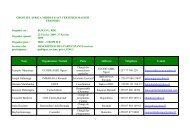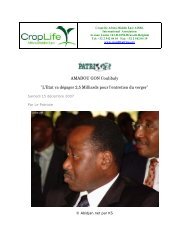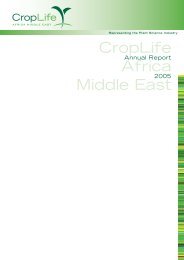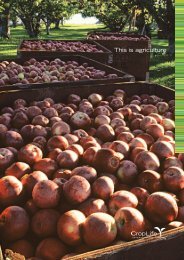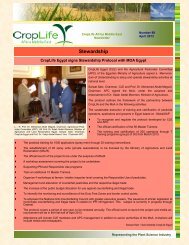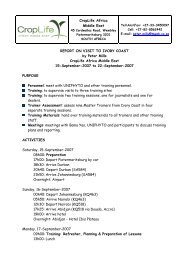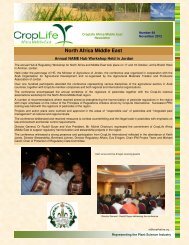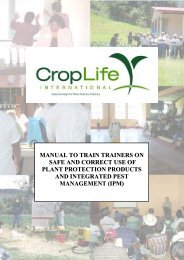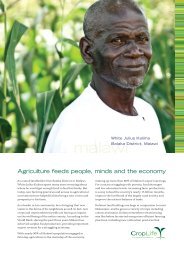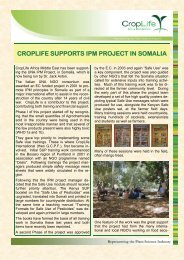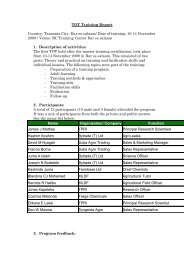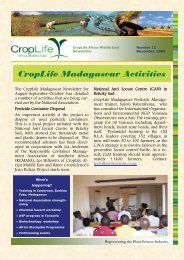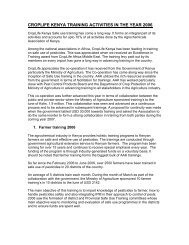Newsletter January 2013 - CropLife Africa Middle East
Newsletter January 2013 - CropLife Africa Middle East
Newsletter January 2013 - CropLife Africa Middle East
Create successful ePaper yourself
Turn your PDF publications into a flip-book with our unique Google optimized e-Paper software.
A SSP Trainer-of-Trainers & Responsible Use Training took<br />
place in Kampala, Uganda 3 – 7 December. Evelyn<br />
Lusenaka managed the training program.<br />
The objectives of the training were met. Participants were<br />
pleased with the refresher on Adult Training and expressed<br />
their satisfaction with the new information of how to train<br />
farmers in the field. Most indicated that the training had<br />
simplified what they otherwise thought was difficult work in<br />
the training of farmers. They especially appreciated the use<br />
of the training instructions developed in training farmers.<br />
The content of the course covered 16 topics in the initial 2<br />
days.<br />
In the individual presentations – topics covered included:<br />
• What are counterfeit and Illegal pesticides<br />
• Identification of counterfeit and illegal pesticides<br />
• How and why to scout<br />
• The pesticide label<br />
• Buying pesticides<br />
• Transporting pesticides<br />
• Storing of pesticides<br />
• Protecting the applicator<br />
• Mixing of liquid pesticides<br />
• Mixing of wettable powders<br />
• Disposal of the empty pesticide container<br />
• Applying pesticides (Do’s and Don’ts)<br />
On the final day participants took part in a field visit on<br />
counterfeit and illegal pesticides. Participants were able to<br />
relate to what they have learnt in the classroom to what<br />
takes place in the field. They were able to see the following:<br />
• Structure and organization of an agrochemicals<br />
company<br />
• Warehousing and storage<br />
• Repacking of pesticides<br />
• How companies protect their products from<br />
counterfeiting and packaging infringements.<br />
<strong>CropLife</strong> <strong>Africa</strong> <strong>Middle</strong><br />
<strong>East</strong> <strong>Newsletter</strong><br />
Stewardship<br />
SSP ToT & Responsible Use Training: Uganda<br />
Evelyn Lusenaka - <strong>CropLife</strong> Kenya<br />
Above: One of the steps in “container<br />
management”<br />
Right: Learning about Personal Protective Equipment<br />
(PPE)<br />
APOLOGY<br />
Number 86<br />
<strong>January</strong> <strong>2013</strong><br />
Dear Readers, please note<br />
the incorrect photo of the<br />
Minister of Agriculture, Mali<br />
was featured on page 10 of<br />
issue no 85.<br />
Dr Yaranga Coulibaly<br />
featured alongside chaired<br />
the 31st session of the<br />
CSP.<br />
Our apologies for any<br />
inconvenience caused.<br />
Representing the Plant Science Industry
Page 2<br />
<strong>CropLife</strong> <strong>Africa</strong> <strong>Middle</strong> <strong>East</strong> <strong>Newsletter</strong> Number 86<br />
<strong>January</strong> <strong>2013</strong><br />
Meetings with Ministry Officials in Cameroon<br />
• Gisèle Etoundi, MINADER-Crop Protection<br />
Directorate, and Master Trainer of <strong>CropLife</strong><br />
Cameroon and <strong>CropLife</strong> AME assessed the<br />
training that took place in 2012, and developed<br />
plans for <strong>2013</strong>.<br />
• Discussions with J-C Ngongang Nono,<br />
Coordinator, ICCO SPS <strong>Africa</strong>n Cocoa for an<br />
update on activities. It was noted that only a few of<br />
the targets have been completed due to the fact<br />
that the Cameroon government only released<br />
funds recently. Contact will be reactivated with<br />
<strong>CropLife</strong> Cameroon (and Gisele Etoundi) for their<br />
involvement and participation in the project.<br />
Training video for Applicators Project Produced in Egypt<br />
<strong>CropLife</strong>, together with ACDI/VOCA, have produced a field training video to be used in<br />
the Applicators Project in Egypt. The video matches safety standards with high quality<br />
measures of pesticide responsible use.<br />
The 30-minute video covers the reading of a pesticide label, the toxicological band,<br />
wearing of Personal Protective Equipment, using different types of sprayers and nozzles<br />
and correct measuring and mixing of pesticides in the field.<br />
The video was produced in an open field with Arabic commentary to explain all<br />
necessary steps. It is intended to produce both an English and French versions to be<br />
used in other countries for possible television usage.<br />
The video is also intended to be broadcasted intensively in a media communications<br />
campaign to provide for awareness raising in the application of pesticides. The<br />
campaign will include coverage on the agricultural satellite station of Egypt. The<br />
awareness campaign is expected to reach 3000 growers and 1500 applicators.<br />
Ali Mohd Ali<br />
Seed Treatment Working Group Meeting: South <strong>Africa</strong><br />
Bama Yao<br />
The Seed Treatment Working Group in South <strong>Africa</strong> met at<br />
the <strong>CropLife</strong> South <strong>Africa</strong> offices on Friday 14 December.<br />
The agenda items covered the following:<br />
• Labeling of Treated Seed<br />
• Management of dust levels<br />
Alexandra Harrison - ACDIVOCA<br />
• Review of Seed Treatment Stewardship<br />
• Empty Container Management<br />
CLAME was asked to act as the link with <strong>CropLife</strong> Canada<br />
who is extremely advanced in the area of Seed Treatment<br />
Stewardship.<br />
Les Hillowitz<br />
Representing the Plant Science Industry
Page 3<br />
<strong>CropLife</strong> <strong>Africa</strong> <strong>Middle</strong> <strong>East</strong> <strong>Newsletter</strong> Number 86<br />
<strong>January</strong> <strong>2013</strong><br />
Regulatory<br />
Meeting with the MD of the PCPB, Kenya<br />
On Monday 3 December a meeting took place with Gladys Maina, MD of the PCPB, regarding<br />
the “Quality Mark”.<br />
The introduction of a Quality Mark on ALL consumer goods was legislated about four years ago.<br />
The implementing agency is the Kenya Bureau of Standards (KEBS) and for the majority of<br />
consumer products the KEBS mark is already found on most labels. This new legislation was<br />
challenged jointly by AAK (<strong>CropLife</strong> Kenya) and the PCPB (Pest Control Products Board) as in<br />
their view the KEBS mark would not bring any added value in the improvement of quality of<br />
CPP’s on the market. They were successful in convincing KEBS that the pesticide sector would<br />
develop their own Quality Mark and as such were given a timeline to do this. The PCPB / AAK<br />
task team opted to go the route, using the services of Sproxil and this is now at an advanced<br />
stage.<br />
The Pilot Phase is scheduled go ahead as soon as possible and is likely to take place early in<br />
<strong>2013</strong>.<br />
The PCPB see the value of the Quality Mark as follows:<br />
• The Mark should not be seen solely as an anti-counterfeiting measure. This is only a<br />
side benefit in the whole scheme of improvements.<br />
• Use of the Mark will be an upliftment in mandatory standards.<br />
• The Mark must have both a value, and give confidence to the consumer.<br />
• That the Mark will move the product “from a registration number on a label through to a<br />
complete info package”<br />
• That the Mark introduces a new level of control. (Ms. Maina mentioned that in<br />
cooperation with PIP, a number of recognized products were analyzed and surprisingly<br />
a large percentage were found to be out of spec)<br />
• That for Industry, “competition will be increased quality” and a plea was made for<br />
<strong>CropLife</strong> member companies to become involved in the Pilot Phase. Les Hillowitz<br />
CEMAC-CPAC REGULATIONS<br />
Gladys Maiana—PCPB<br />
On 6 December, the CAPC office, and the Plant Protection Directorate, Ministry of Agriculture and Rural Development, met in<br />
Yaoundé, Cameroon. Two separate meetings by the Regional Coordinator took place with:<br />
• The Permanent Secretariat of CPAC (B. Bouato, and 6 regulators).<br />
• Syxtus Nuza, Director of Regulations, Quality Control of Agricultural Inputs and Products (Réglementations et Contrôle<br />
de la Qualité des Intrants et Produits Agricoles).<br />
The purpose of the meeting was the following:<br />
• To exchange on the planned activities of the CPAC as indicated during the WCA Hub Meeting in April. The Permanent<br />
Secretary indicated that most documents needed for the submission dossier would be available by early <strong>2013</strong>. However<br />
the “fast track registration procedure” planned for the first registration could not be initiated, as the few dossiers received<br />
could not justify the move towards this process.<br />
• The Permanent Secretary and S. Nuza, recognized the difficulties for implementing the CPAC framework. The CPAC<br />
Secretariat and MINADER are working together on developing an improved framework and are looking forward to the<br />
future Director General to be in office by early <strong>2013</strong> to support this process.<br />
• The planned activities of <strong>CropLife</strong> <strong>Africa</strong> <strong>Middle</strong> <strong>East</strong> in support of the CPAC for <strong>2013</strong> were presented to both parties.<br />
They both indicated their availability to participate and provide the needed support to such activities. These activities will<br />
focus mainly on the registration procedures (labeling, trials protocol, etc.) for the effective implementation of the CPAC<br />
framework. Bama Yao<br />
Representing the Plant Science Industry
Page 4<br />
<strong>CropLife</strong> <strong>Africa</strong> <strong>Middle</strong> <strong>East</strong> <strong>Newsletter</strong> Number 86<br />
<strong>January</strong> <strong>2013</strong><br />
Intellectual Property Rights / Anti-Counterfeiting<br />
Anti-Counterfeiting Training of Customs Officers - Côte d’Ivoire<br />
Col Baillet, Regional Director of Customs in San-Pedro who<br />
attended the programme was presented a certificate (A)<br />
which he proudly displayed (B) to other participants.<br />
On 19 December, in San-Pédro, a South Western region of Côte<br />
d’Ivoire, 27 operational customs agents of whom 21 were from the<br />
San-Pédro Regional Directorate (city and neighboring cities), and 6<br />
from Man and Daloa regions, approximately 450 Km and 300 Km from<br />
San-Pedro respectively were trained.<br />
The training was a continuation of the rollout of the anti-counterfeiting<br />
course to sensitize customs authorities on the issue, and to provide<br />
knowledge and tools to combat the illegal trade in pesticides.<br />
San-Pédro is an important port for cocoa exports besides being the<br />
capital of the south western region, the largest cocoa growing area in<br />
Côte d’Ivoire. Both Man and Daloa are also important cocoa growing<br />
areas. Illegal pesticides are usually found in these 3 important cocoa<br />
growing regions whilst cocoa is a strategic crop for Côte d’Ivoire, the<br />
world’s largest producer and supplier of around 40% of dry cocoa<br />
beans. Combating illegal pesticides will improve cocoa productivity and<br />
quality thus impacting positively on the income of farmers and the<br />
economy of the country as a whole.<br />
The training was facilitated by Roger Yeboué, Master trainer of<br />
<strong>CropLife</strong> <strong>Africa</strong> <strong>Middle</strong> <strong>East</strong> and Executive Secretary of <strong>CropLife</strong> Côte<br />
d’Ivoire. The course was conducted using an interactive approach to<br />
ensure full participation of the participants. Discussions covered:<br />
• Pesticides and pesticide regulations in Côte d’Ivoire focusing on<br />
the registration procedures.<br />
• Basics on pesticides covering toxicity.<br />
• Reading a pesticide label.<br />
• Illegal and counterfeit pesticides with a focus on the impact on productivity and health, and financial and losses.<br />
• Inspection of shipping documents.<br />
Copies of the appropriate pesticide regulations related to the registration, production, and distribution of crop protection<br />
products as well as the list of registered products in the country was distributed to each participant.<br />
The Regional Director of Customs Services attended the full programme and at the end stressed the importance and value of<br />
the programme. The participants shared this view and requested that such programs be carried out often, allowing for frequent<br />
meetings and exchanges between the industry and the customs services. Bama Yao<br />
Participants focusing on the facilitator<br />
covering the issue of the illicit pesticides<br />
trade<br />
Representing the Plant Science Industry
Page 5<br />
<strong>CropLife</strong> <strong>Africa</strong> <strong>Middle</strong> <strong>East</strong> <strong>Newsletter</strong> Number 86<br />
<strong>January</strong> <strong>2013</strong><br />
Association Management<br />
<strong>CropLife</strong> Kenya<br />
Time was taken to meet with Richard Sikuku, CEO, <strong>CropLife</strong> Kenya and Kuria Gatoyne, Chairman, <strong>CropLife</strong> Kenya. Discussions<br />
focused on the following:<br />
• Stewardship issues including “training plans for <strong>2013</strong>”, the closure of the CleanFarms project, the pilot container<br />
management program and the possible development of an SSP project.<br />
• Regulatory, included the need to hold a POR workshop before the Hub Meeting in August.<br />
• IPR / Anti Counterfeiting, included details of what was accomplished in 2012 and plans for <strong>2013</strong>. Also covered were the<br />
training needs for <strong>2013</strong> and the resources needed from CLAME to accomplish this.<br />
• Under the topic, Association Management, there is a need to re-strategize and to achieve this; Association Management<br />
training will be arranged.<br />
• The use of Evelyn Lusenaka as a training resource for the region. Les Hillowitz<br />
<strong>CropLife</strong> Uganda<br />
Discussions with Stephen Matovu, Chairman of <strong>CropLife</strong> Uganda and Betty Atto, Secretariat yielded the following:<br />
• CLU see the IFDC “Scratch Card” anti-counterfeiting pilot project as being a success.<br />
• The aBi project, which is now in its final phase, is going extremely well and all the targets set will be met. What has<br />
emerged from this project is that <strong>CropLife</strong> Uganda have developed a valuable resource in their 12 Field Coordinators.<br />
This is now a refined group of multi-skilled trainers, all located in the North, which is the focal point for donor funding.<br />
• The Feed the Future Agricultural Inputs Activity (FTF Ag-Inputs) has been awarded to Tetra Tech ARD.<br />
• Tetra Tech ARD is presently managing the LEAD project in the country. (The LEAD project is the successor to APEP that<br />
was managed through Chemonics and of which the Chief of Party (COP) was Clive Drew supported by Mark Woods.<br />
Clive Drew is presently the COP of the aBi Trust). Eric Derks is the newly appointed COP of the LEAD project and who<br />
will be responsible to kick-start the FTF Ag-Inputs project. The LEAD project closes at end March <strong>2013</strong> suggesting that<br />
the FTF project can at the earliest start April or later in the year. The FTF Ag-Inputs project will cover the North of the<br />
country and in many cases overlap with the districts covered by the aBi Trust project. This means that CLU has the<br />
capacity to support the project. Les Hillowitz<br />
<strong>CropLife</strong> Cameroon<br />
On 5 December, at the Sofitel Méridien, Douala, Bama Yao conducted an Association Management intervention at which 6<br />
member companies of <strong>CropLife</strong> Cameroon were represented.<br />
The key points covered were:<br />
• Feedback on the activities conducted in 2012 focusing mainly on the fight against the illegal trade in pesticides and the<br />
continuous training on IPM/RU conducted jointly with the Ministry of Agriculture and Rural development. The sensitization<br />
tour to the major agricultural regions to see firsthand the illicit pesticides trade was well received by stakeholders. This<br />
led to the continued support and links with other sectors and organizations having the same objectives. The joint<br />
stewardship training programme with MINADER benefited 318 participants, a 50% increase compared to the previous<br />
year. Participants expressed great interest in the sessions, but financial constraints limit the possibility of increasing the<br />
number of interventions.<br />
• To brief <strong>CropLife</strong> Cameroon on the outcome of the <strong>CropLife</strong> AME Board meeting, particularly on the commitment and<br />
alignment to the policies and standards of <strong>CropLife</strong> AME by the national associations. <strong>CropLife</strong> Cameroon is currently<br />
revising their Articles of Association to include a clause on a Code of Conduct and related sanctions against misbehavior<br />
cases.<br />
• The implementation of the WCF-ACI programme (component 4) by <strong>CropLife</strong> <strong>Africa</strong> <strong>Middle</strong> <strong>East</strong> through the national<br />
associations in the target countries and <strong>CropLife</strong> Cameroon is expected to implement these activities in Cameroon.<br />
There is obvious enthusiasm from <strong>CropLife</strong> Cameroon to support the programme. They will link and seek participation<br />
with some partners, particularly the coffee-cocoa development funds (Fonds de développement du café-cacao,<br />
FODECC) in charge of the implementation of a national programme to improve production and the quality of coffee<br />
cocoa. The SPP trainers and SSPs are expected to be selected by FODECC under the supervision of <strong>CropLife</strong><br />
Cameroon. Bama Yao<br />
Representing the Plant Science Industry
Photos: Medina FM<br />
Page 6<br />
<strong>CropLife</strong> <strong>Africa</strong> <strong>Middle</strong> <strong>East</strong> <strong>Newsletter</strong> Number 86<br />
<strong>January</strong> <strong>2013</strong><br />
Communications<br />
<strong>CropLife</strong> Morocco Communicates Via Rural Radio<br />
For the first time, <strong>CropLife</strong> Morocco is using rural radio to spread key<br />
messages on the responsible use of pesticides among farming communities.<br />
The reaction has been extremely positive and therefore <strong>CropLife</strong><br />
Morocco plans to make more use of local radio stations in the future to<br />
reach small-scale farmers.<br />
The choice of rural radio to reach farmers was obvious for <strong>CropLife</strong><br />
Morocco since the majority of farmers live in remote areas with limited<br />
access. By using rural radio, most farmers can be reached without<br />
logistical challenges.<br />
A total of ten different radio spots were aired over a period of three months<br />
at the end of 2011 and in early 2012. The items focused on different<br />
aspects of responsible use of pesticides, including Integrated Pest<br />
Management, application, storage, and the transportation of pesticides.<br />
Each spot took between 60 and 90 seconds in which only key messages<br />
were covered.<br />
The spots were broadcasted via Radio Medina FM, based in Meknes,<br />
which is in the centre of the country and in the middle of the most<br />
important agricultural region in Morocco. It is also the region where most<br />
incidents occur with pesticides. The languages used were Arabic and<br />
Berber, which are the most common languages used by small-scale<br />
farmers in Morocco. The radio spots could be heard five days a week,<br />
twice per day at 7h45 in the morning and 6h45 in the evening which is the<br />
time that most farmers are back from their fields and listen to the radio.<br />
The making and airing of the radio spots were self-financed by <strong>CropLife</strong><br />
Morocco. Ali Mohd Ali<br />
Farming First in Progress<br />
As a co-organiser, Farming First partnered with the Agriculture, Landscapes and Livelihoods Day consortium, bringing<br />
together the CGIAR, FANRPAN, WFP, IFAD, the World Bank, FAO, World Farmers Organisation and others - to promote<br />
agriculture within the broader policy discussions at the Climate Change Conference (COP18) in Doha.<br />
As part of this effort and in partnership with the CGIAR Research Program on Climate Change, Agriculture and Food Security<br />
(CCAFS), Farming First has launched its newest infographic, “The Story of Agriculture and Climate Change: The Road to COP<br />
18”. Unveiled ahead of the opening session of Agriculture, Landscapes and Livelihoods Day 5 (ALL-5 Day), it tells the history<br />
of agriculture and climate change in the UNFCCC, highlighting how discussions on agriculture are spread across the<br />
convention and the growing consensus on the need for cohesion to leverage efforts in research, knowledge sharing and<br />
financing for adaptation and mitigation.<br />
Farming First also hosted a roundtable session at ALL-5 Day on the role of public-private partnerships in reducing emission<br />
across the agro-food chain. The session highlighted best practices and technologies, with speakers discussing how farmers,<br />
businesses, NGOs and governments are collaborating to develop reliable metrics to measure how mitigation and adaptation<br />
goals are being met from farm to fork. The panel included:<br />
• Dyborn Chibonga, Chief Executive Officer, National Smallholder Farmers’ Association of Malawi<br />
• Simon Aumonier, Partner & Head of Waste Management, Energy and Climate Change Teams, Environmental<br />
Resources Management<br />
• Keith Wheeler, Co-founder of Foundation for our Future, President of IUCN Board of Directors, and Field to Market<br />
Board Member<br />
• Belinda Morris, American Carbon Registry California Director<br />
Lastly, Farming First worked with other leading agricultural organisations to promote a joint call-to-action for further<br />
consideration at the COP18 meeting for a dedicated SBSTA Work Programme on Agriculture. Other endorsers include CGIAR<br />
Consortium, World Farmers’ Organisation and the Technical Centre for Agricultural and Rural Cooperation (CTA) among<br />
others.<br />
Representing the Plant Science Industry
Page 7<br />
<strong>CropLife</strong> <strong>Africa</strong> <strong>Middle</strong> <strong>East</strong> <strong>Newsletter</strong> Number 86<br />
<strong>January</strong> <strong>2013</strong><br />
Plant Biotechnology<br />
Tanzania<br />
Tanzania has joined neighbours Kenya and Uganda in a novel project to farm drought resilient maize called WEMA, which is<br />
acronym for Water Efficient Maize for <strong>Africa</strong>. The preparatory stages, scientifically known as confined field trials (CFTs) are<br />
done and our scientists are confident that we have what it takes to move on to the next stage – of doing actual research with<br />
transgenes from genetically modified seeds.<br />
Apart from maize, cotton could also be headed for a major, fresh comeback to abandoned fields across traditional<br />
cotton-growing areas as well as ‘no-go’ regions to the south of Tanzania when current research produces a new seed resilient<br />
enough to thrive under harsh drought conditions and insect attacks.<br />
But there’s also a big “if” into the equation. So far field trials on Bt cotton, the new variety that is genetically enhanced to<br />
withstand drought and insect pests, are now being carried out in neighbouring Kenya, where biosafety rules are less stringent.<br />
However, our experts at home, such as Dr Roshan Abdallah, who heads the country’s plant biosafety centre of excellence in<br />
Tanzania, says such trials still cannot be done at home because of the country’s ‘strict liability’ clause in the 2009 biosafety<br />
regulatory regime that holds everyone down the supply line liable to legal sanctions should anything go wrong.<br />
The ‘Strict Liability’ clause provides, among other things, that ‘a person who imports, arranges transit, makes use of, releases<br />
or places on the market a GMO or a product of a GMO shall be strictly liable for any harm caused by such a GMO “and that<br />
“the harm shall be compensated”<br />
That’s where we remain stuck as a country; we are still debating on how to compensate people in the event of possible harm<br />
from largely hypothetical dangers. The world has been consuming GM foods for nearly three decades now without any<br />
scientific evidence of harm to either human or animal health.<br />
And, as we keep talking, our neighbours have joined the rest of the world and could soon be producing GM maize and Bt<br />
cotton commercially—in the next two years or so in the case of Kenya. Given our porous borders and truly inefficient border<br />
patrols we could soon be eating GM food produced next door, all the while pretending to be “protecting” our people imaginary<br />
harm.<br />
The economic cost behind our lack of resolve is all too familiar. Cotton, for instance, is Tanzania’s largest export crop after<br />
coffee, bringing in a handsome $90 million to export earnings and sustains, directly and indirectly, the lives of some 48 percent<br />
of the country’s population currently estimated at 38 million.<br />
Primarily, cotton is produced by about 500,000 smallholders in 42 districts on farms ranging from 0.5 to 10 hectares – national<br />
average 1.5ha – in 13 of the regions in mainland Tanzania. Most farmers do not use fertilizer or other chemicals, mechanized<br />
(or even animal) power, or irrigation.<br />
Photos Courtesy Monsanto<br />
Representing the Plant Science Industry
Page 8<br />
<strong>CropLife</strong> <strong>Africa</strong> <strong>Middle</strong> <strong>East</strong> <strong>Newsletter</strong> Number 86<br />
<strong>January</strong> <strong>2013</strong><br />
Tanzania cont..<br />
More than 90 percent of the cotton is produced to the south of Lake Victoria in Mwanza, Shinyanga, Mara, Tabora, Kigoma, and<br />
Singida region, with just three of them – Singida, Mwanza and Shinyanga – accounting for over 80 percent of the crop; the rest<br />
comes from the <strong>East</strong>ern parts of the country.<br />
With Bt cotton, we will be talking about more than the miserly 410,000 ha which are currently being sown to cotton during most<br />
farming seasons, and at almost zero risk from pest infestation.<br />
In the meantime, climate change is also for real – and ‘going biotech’ is about the best policy decision we could be making at the<br />
moment.<br />
Elsewhere across the world, biotechnology is proving to be the best way to providing food for a hungry tomorrow. The most<br />
compelling testimony to biotech crops is that, in the period 1996 to 2011, millions of farmers in 29 countries worldwide, made<br />
independent decisions to plant and replant biotech crops.<br />
One principal reason underpins the trust and confidence of risk-averse farmers: biotech crops deliver sustainable and<br />
substantial, socioeconomic and environmental benefits.<br />
As a resource-poor country, Tanzania cannot afford to feed on the fears of a largely uninformed anti-GM lobby – some of whose<br />
opponents eat GM food or survive on GM medicinal products even as they bad-mouth them.<br />
SOURCE: THE GUARDIAN - TANZANIA<br />
Malawi<br />
Scientists at Malawi’s leading agricultural college, Bunda, have disclosed that the first-ever genetically modified cotton<br />
‘confined field trial’ will start this growing season at college located on the outskirts of the capital Lilongwe.<br />
One of the scientists Dr Moses Maliro said that the genetically modified cotton, commonly known as BT cotton, would be<br />
planted once Bunda receives sufficient rains for planting.<br />
“By now we are at a stage whereby the seed for this variety is already in the country”, he said. “It is being kept under the<br />
custody of the Department of Environmental Affairs waiting for the next steps to treat it and then planting as soon as the rains<br />
come at Bunda.”<br />
The seed was procured from South <strong>Africa</strong>, which is now celebrating 15 years of growing and commercialization of genetically<br />
modified crops including cotton.<br />
The BT cotton trial at Bunda commences this year after it failed in the last growing season due to delays in procuring the seed,<br />
among other bureaucratic problems.<br />
It took almost two years since Bunda made the application to the bio-safety regulator hosted by the environmental affairs<br />
department for the trial to be approved on October 7, 2011.<br />
As the trial for the genetically modified cotton starts, some modifications have been made, according to Dr Maliro, a member of<br />
a seven-man team overseeing the research at Bunda College.<br />
Instead of conducting a trial for a variety of cotton that will both be resistant to bollworms and tolerant to herbicides, only one<br />
trait - the bollworm resistant (Bollgard II) - will be tested.<br />
“With the delay in mobilizing the resources, it become cheaper to just look at one event instead of looking at the two events<br />
and at the moment the pest is the major problem and should herbicide tolerant variety be necessary, I am sure that could be<br />
implemented later on,” disclosed Dr Maliro.<br />
The seasoned crop breeder said by the end of this growing season<br />
Malawians will be updated on initial results of the trial which might<br />
take up to three years to come up with conclusive results.<br />
“Stakeholders will be briefed on how the crop is performing and what<br />
has the data shown because the BT cotton will be compared against<br />
the local variety. So, yes, every stakeholder needs to know how it has<br />
performed; is it beating our local varieties and can we take it for<br />
further trials in other locations?” he alluded to some of the aspects on<br />
which the public will updated<br />
Representing the Plant Science Industry
Page 9<br />
<strong>CropLife</strong> <strong>Africa</strong> <strong>Middle</strong> <strong>East</strong> <strong>Newsletter</strong> Number 86<br />
<strong>January</strong> <strong>2013</strong><br />
Malawi cont..<br />
The trial at Bunda is expected to improve cotton output in the country by over three fold due to reduced costs of on-field<br />
chemical use which is the most costly part of cotton production based on estimates collected in South <strong>Africa</strong>n where BT cotton is<br />
widely grown.<br />
“In my first year in 2002, I managed to produce 2500 kg/hectare," said Frans Malera, a South <strong>Africa</strong> farmer from Limpopo<br />
Province who was in Malawi recently.<br />
Currently the average cotton yield in Malawi is 1000 kilograms per hectare.<br />
Caroline Theka, a senior official in the Environmental Affairs Department (EAD) told an outreach-planning meeting hosted by<br />
South <strong>Africa</strong>’s based <strong>Africa</strong>Bio in Lilongwe on Friday, December 7, that the trial sponsored by the global seed producer<br />
Monsanto will closely be monitored by the authorities.<br />
According to Dr Nompumelelo Obokoh, the CEO of <strong>Africa</strong>Bio, the meeting was convened to draft a holistic outreach and public<br />
awareness program, which she said is essential as the confined field trial, starts at Bunda, saying her organization will provide<br />
support where necessary.<br />
Apart from scientists from Bunda and EAD, officials attended the meeting from the Programme on Bio-safety Systems (PBS)<br />
under the National Commission for Science and Technology, Farmers Union of Malawi, Monsanto and fabric producers Mapeto<br />
David Whitehead and Sons.<br />
BT cotton is named as such because it contains a bacterium called bacillus thurengiensis (bt), which produces chemicals that<br />
kill bollworms when inserted into the cotton gene. This reduces the need for chemical spraying by almost half of the required<br />
eight times in a rainy season. — Zodiak Online<br />
Moses Kwapata Principal Bunda College<br />
CleanFarms “Handover workshop, Nairobi Jan 28-30<br />
Anti-Counterfeiting Training, Zambia Feb 8<br />
Meeting of the CPSC in Washington Feb 12<br />
Meeting of the Anti Counterfeiting Steering Committee Feb 13<br />
Association Management Training, <strong>CropLife</strong> Zambia Feb 25-26<br />
Container Management Workshop, Zambia Feb 27-28<br />
<strong>Africa</strong> Region Plant Biotech Workshop, Ghana March 4-8<br />
Meeting of the Regional Regulatory Committee March 13-14<br />
Hub and Regulatory Meeting, West and Central <strong>Africa</strong> Apr 16-17<br />
Representing the Plant Science Industry
Contributors:<br />
Page 10<br />
<strong>CropLife</strong> <strong>Africa</strong> <strong>Middle</strong> <strong>East</strong> <strong>Newsletter</strong> Number 86<br />
<strong>January</strong> <strong>2013</strong><br />
Ali Mohamed Ali (North <strong>Africa</strong> <strong>Middle</strong> <strong>East</strong>) ali@croplifeafrica.org<br />
Bama Octave Yao (West-Central <strong>Africa</strong>) bama@croplifeafrica.org<br />
Les Hillowitz (<strong>East</strong>-Southern <strong>Africa</strong>) les@croplifeafrica.org<br />
GROWING FOOD - CREATING RENEWABLES - SUPPLYING SUSTAINABLY<br />
Representing the Plant Science Industry



